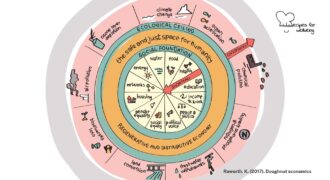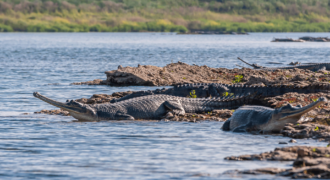Introduction
Sustainability as a topic has always interested me owing to my love for nature and all its myriad creations and the vivid stories that came out of its fascinating fabric of existence. For many years now, I have carried my own bottle of water and chosen a lifestyle that has the least impact of the planet, even if caused me discomfort, at times. However, I always wondered is sustainability is practical, enough for people to #MakeItTheirs. I take this opportune moment of observing World Nature Conservation Day (July 28, 2023) to throw light on the practicality of sustainability, one that is beyond altruism.
Biodiversity & Economics
Biodiversity refers to the variety of life on Earth and the habitats in which they live. It is essential for the functioning of ecosystems, which provide goods and services that support human well-being and economic development. However, biodiversity is under threat from human activities such as land use change, overexploitation, pollution, climate change, and invasive species. According to the IPBES Global Assessment Report on Biodiversity and Ecosystem Services 2019 (Sustainable Business Network and Consultancy, n.d.), around one million animal and plant species are threatened with extinction, many within decades.
Businesses depend on and impact biodiversity in various ways. For example, they rely on natural resources such as water, soil, timber, and crops for their production processes. They also affect biodiversity through their emissions, waste, and land use. Businesses can benefit from biodiversity by enhancing their reputation, reducing costs, increasing revenues, and creating new opportunities. However, they also face risks from biodiversity loss, such as reduced availability and quality of resources, increased regulation and litigation, and damage to their brand and social license to operate.
Therefore, it is important for businesses to integrate biodiversity into their nature strategy, which is a plan to manage their dependencies and impacts on nature in a way that creates value for both the business and society. A nature strategy can help businesses to identify and measure their biodiversity footprint, set targets and actions to reduce it, monitor and report on their progress, and engage with stakeholders to communicate their commitments and achievements. A nature strategy can also help businesses to align with global frameworks such as the UN Sustainable Development Goals (SDGs), the Convention on Biological Diversity (CBD), and the Task Force on Nature-related Financial Disclosures (TNFD).
Some examples of how businesses can integrate biodiversity into their nature strategy are:
- Adopting a risk management framework, such as the Natural Capital Protocol (n.d. Deloitte United States), to assess their nature-related dependencies and impacts across their value chain.
- Implementing best practices and standards, such as the Business and Biodiversity Offsets Programme (BBOP) (Do Better | Esade Insights & Knowledge hub, n.d.), to avoid, minimize, restore, and offset their biodiversity impacts.
- Investing in nature-based solutions, such as restoring ecosystems or supporting conservation projects, to enhance biodiversity and generate co-benefits such as carbon sequestration, water regulation, and disaster risk reduction.
- Collaborating with other businesses, governments, NGOs, and communities to develop and implement joint initiatives that address common biodiversity challenges and opportunities.
By integrating biodiversity into their nature strategy, businesses can contribute to the conservation and restoration of biodiversity while also creating value for themselves and society. This is not only a moral duty but also a smart business decision that can help businesses to secure their long-term viability and competitiveness in a changing world.
There are several tools and services that can help businesses measure their biodiversity footprint, which is the impact of their activities on the variety of life on Earth. Some of these tools are:
- Biodiversity Impact Analytics: A tool that calculates the impact of financial portfolios on biodiversity using a metric called Potential Avoided Extinction (PAE). It also provides recommendations for reducing the impact and enhancing positive outcomes for biodiversity (WWF – Building a future in which humans live in harmony with nature, n.d.).
- Biodiversity Footprint for Financial Institutions: A tool that assesses the biodiversity footprint of financial institutions’ investments and loans using the GLOBIO model, which estimates the mean species abundance (MSA) of original species in a given area under different pressure factors (European Commission, 2014, 10).
- Corporate Biodiversity Footprint: A tool that measures the biodiversity footprint of corporate activities using the same GLOBIO model as above, but applied at the local scale. It also allows for scenario analysis and comparison of different biodiversity-friendly measures (Plansup, n.d).
- Net Environmental Contribution Initiative: A tool that evaluates the environmental performance of financial products and portfolios using a score that ranges from -100% (highly detrimental) to +100% (highly positive). It covers six environmental themes, including biodiversity (IRIS+ System, 2019).
- Portfolio Impact Footprint: A tool that quantifies the environmental and social impacts of investment portfolios using a set of indicators that cover various dimensions of sustainability, including biodiversity (IRIS+ System, 2019).
- Sustainable Investment Framework Navigator: A tool that helps investors to select and apply the most suitable sustainable investment frameworks for their objectives and preferences. It covers several frameworks that address biodiversity issues, such as the Natural Capital Protocol and the TNFD (IRIS+ System, 2019).
- Portfolio Impact Analysis Tool for Banks: A tool that enables banks to measure and manage the environmental and social risks and opportunities of their lending portfolios. It covers several environmental themes, including biodiversity (IRIS+ System, 2019).
These are some examples of how businesses can measure their biodiversity footprint using different tools and methods. However, it is important to note that these tools have different scopes, assumptions, data sources, and limitations, and therefore may not be fully comparable or accurate. Therefore, businesses should use these tools with caution and complement them with other sources of information and expert advice.
Sustainability is a broad and complex topic, but to break it down it can be understood as the ability to meet the needs of the present without compromising the ability of future generations to meet their own needs. Sustainability is about balancing the environmental, social, and economic, the triple bottom line (The triple bottom line: What it is & why it’s important, 2020, December 8) aspects of human activities, so that we can live well without harming the planet or other people.
References
(n.d.). Deloitte United States. https://www2.deloitte.com
(n.d.). Do Better | Esade Insights & Knowledge hub. https://dobetter.esade.edu
(2014, 10). European Commission | Choose your language | Choisir une langue | Wählen Sie eine Sprache. https://ec.europa.eu
(n.d.). Plansup | Consultancy on planning support. https://plansup.nl
(n.d.). Sustainable Business Network and Consultancy | BSR. https://bsr.org
The triple bottom line: What it is & why it’s important. (2020, December 8). Business Insights Blog. https://online.hbs.edu/blog/post/what-is-the-triple-bottom-line











adamgordon
April 22, 2021Thanks for sharing this information is useful for us.